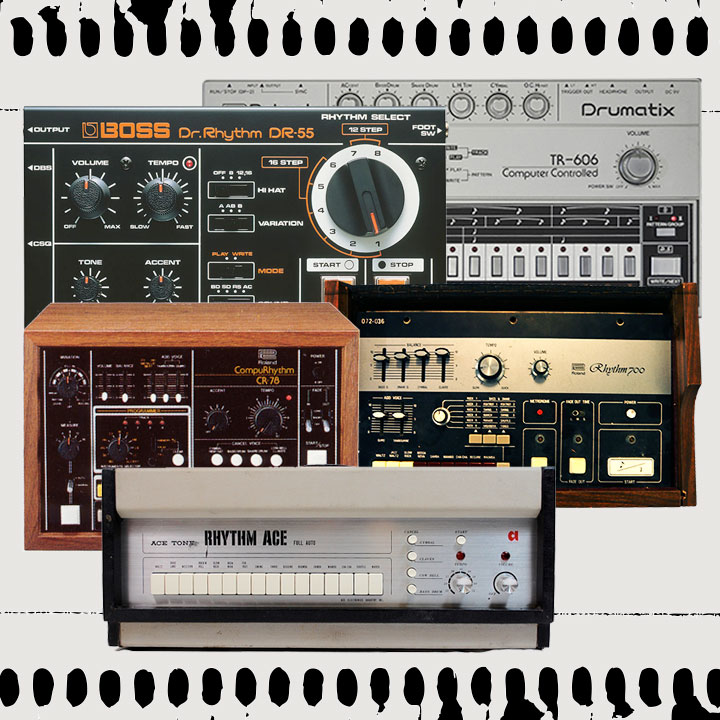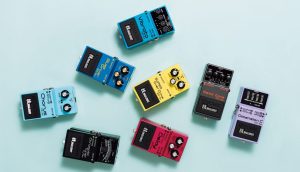In 1960, Ikutaro Kakehashi founded the company Ace Electronic Industries, Inc. At the time, Kakehashi was a young inventor with a passion for electronics, experimentation and music. Over the years, he tried his hand at creating various electronic instruments – from organs and guitar amplifiers, to the Theremin and the Ondes Martenot. However, it wasn’t until he came across a Wurlitzer Side Man in 1963 that his long standing interest in the drum machine began. Kakehashi then began to develop his own version of a rhythmic accompaniment for organ players of the time. The rest is history…
Contributed by Hannah Lockwood for the Roland Australia Blog
INDEX
1964 – 1972 Ace Electronics
1972 – 1979
1980 – 1989
1990 – 1999
2000 – 2016
Ace Electronic 1964 – 1972
Rhythm Ace R-1
Kakehashi developed a prototype of the world’s first fully transistorized, non-automatic percussion instrument. It had no preset patterns but instead sounded individual percussion hits when the buttons were pressed. This made it quite useless for an organist, who was the most likely customer at the time of its release. It was debuted at the Summer NAMM Show in 1964, and while it failed to be commercialized, it did lay the foundations for future designs.
Rhythm Ace FR-1
 To meet the market’s desire for an automatic rhythm machine, Kakehashi began to develop a circuit named a diode matrix. This produced rows of pulses that would determine the sound-making position of each instrument in the machine. This culminated in the FR-1 rhythm machine. It hosted 16 preset patterns and four buttons to manually play each instrument voice, which included cymbal, claves, cowbell and bass drum. The rhythm patterns could be combined by pressing multiple rhythm buttons simultaneously, providing over 100 possible rhythm combinations. So popular was the design, it was later adopted by the Hammond Organ Company, who began to incorporate the FR-1 presets into their latest organ models.
To meet the market’s desire for an automatic rhythm machine, Kakehashi began to develop a circuit named a diode matrix. This produced rows of pulses that would determine the sound-making position of each instrument in the machine. This culminated in the FR-1 rhythm machine. It hosted 16 preset patterns and four buttons to manually play each instrument voice, which included cymbal, claves, cowbell and bass drum. The rhythm patterns could be combined by pressing multiple rhythm buttons simultaneously, providing over 100 possible rhythm combinations. So popular was the design, it was later adopted by the Hammond Organ Company, who began to incorporate the FR-1 presets into their latest organ models.
Rhythm Ace FR-2L
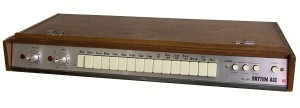 Released 3 years later, the FR-2L improved on the FR-1 design. This newer release was a slim-line design, made to sit atop of an organ. It was missing the Bass Drum and Cowbell cancelling buttons of its predecessor, but now featured a cancel button for the Cymbal, Clave and Snare voices. All other controls were identical, and appeared in reverse order on the FR-2L.
Released 3 years later, the FR-2L improved on the FR-1 design. This newer release was a slim-line design, made to sit atop of an organ. It was missing the Bass Drum and Cowbell cancelling buttons of its predecessor, but now featured a cancel button for the Cymbal, Clave and Snare voices. All other controls were identical, and appeared in reverse order on the FR-2L.
Hammond FR-2D
Almost identical to the FR-2L, aside from the black faceplate and wooden music stand, this device was sold by Hammond Organs as the Hammond Auto Rhythm. It offered 16 rhythms, with the ability to combine multiple patterns. Combining patterns expanded the FR-2D to over 100 available preset pattern combinations.
Rhythm Ace FR-20
The FR-20 was a floor type rhythm unit with four available voices.
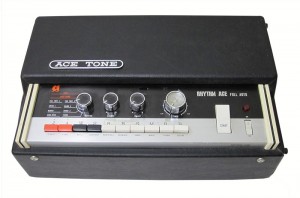 Rhythm Ace FR-3
Rhythm Ace FR-3
This machine came with 8 different preset sounds, alongside buttons for the 2-beat and 4-beat variations. It also offered individual controls for balance, volume, variation and tempo. The FR-3 would later be reimagined in Kakahashi’s Roland TR Series.
Rhythm Ace FR-3S
Released by Multivox, the key difference between this device and the FR-3 was the outputs. The FR-3S had Trig Out, Foot Switch, and Sig Out. It offered the usual balance, volume and tempo controls, alongside a Selector switch for moving between rhythms.
Rhythm Ace FR-4
This device featured 20 presets, from waltz, ballad, cha-cha, beguine, bossa nova, haba-nera and more. The preset rhythms had 2-beat and 4-beat variations, with certain beats accenting different sounds. Combining rhythm patterns gave the user more variation and flexibility. It also offered a balance control, which adjusted the balance between bass drum and cymbal sounds.
Rhythm Ace FR-6
This analog preset drum machine shared the same patterns as the FR-4, with the exception of Slow Rock replacing the Disco preset. The main panel featured individual controls for volume, balance, tempo and variations.
Rhythm Ace FR-6P
This machine came in two different style cases. The FR-6P was identical to the FR-6 but was finished with leatherette rather than wood. The FR-6 design would later be updated and released by Kakahashi in Roland’s TR Series.
Rhythm Ace FR-6M
This device offered the same controls as the standard FR-6, with some obvious aesthetic differences. It was rebranded and sold by Multivox.
Rhythm Ace FR-7L
This preset rhythm machine came with a variety of presets and featured dedicated controls for volume, balance and tempo. It also offered 2 variation presets which hosted 6 modes in each, making it a rather flexible machine for its time. It would later be reimagined by Kakehashi in Roland’s TR Series.
Rhythm Ace FR-7M
This vintage drum machine was released by Multivox. It had individual volume controls for Bass, Snare, Guiro and Maracas/Cymbal/Hi-Hats. It came with 8 preset rhythms, alongside 10 Latin rhythms, with additional combinations. It also featured a metronome, fade time and tempo control,
Rhythm Ace FR-8L
With its wood finish and built-in music stand, the FR-8L was primarily designed to be used alongside an organ. It had individual volume control for its sounds, which provided the user with more control over the drum mix. It would later go on to be updated and released as Roland’s first drum machine, the TR-77.
Roland 1972 – Present
On April 18 1972, Ikutaro Kakehashi founded Roland Corporation, continuing his legacy of innovation in the field of electronic musical instrument design. He would go on to develop some of the most forward thinking, inspirational and acclaimed electronic instruments ever made, shaping the course of music history.
1972
TR-77 Rhythm 77
 This rhythm box was one of the first ever products released by Roland Corporation, and is an updated version of the Ace Tone Rhythm FR-8L. It allowed users to merge patterns, had independent volume controls for each instrument, a fade out feature, and 2-beat and 4-beat pattern variations. Designed with organists in mind, it was taken on by Hammond and is now also widely known as the Hammond Rhythm Unit.
This rhythm box was one of the first ever products released by Roland Corporation, and is an updated version of the Ace Tone Rhythm FR-8L. It allowed users to merge patterns, had independent volume controls for each instrument, a fade out feature, and 2-beat and 4-beat pattern variations. Designed with organists in mind, it was taken on by Hammond and is now also widely known as the Hammond Rhythm Unit.
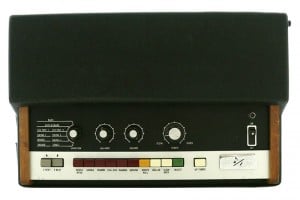 TR-55 Rhythm Arranger
TR-55 Rhythm Arranger
Also part of the original TR range, this machine offered similar sounds and controls to the TR-77. All machines in this series were made using analog voice circuits, with the TR standing for Transistor Rhythm. This model, with its table top design, was an updated version of the Ace Tone Rhythm FR-6.
TR-33 Rhythm Arranger
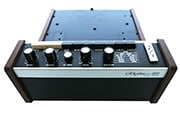 Similar to other models in the early TR range, but with more limitations than the others, this rhythm box had a cut-out body shape for mounting underneath a piano or organ. Using analog voice circuits to create its sounds, the TR-33 offered approximately 20 preset rhythms. It also featured a balance knob that allowed the user to mute certain drum sounds, allowing for the possibility of more rhythmic variations.
Similar to other models in the early TR range, but with more limitations than the others, this rhythm box had a cut-out body shape for mounting underneath a piano or organ. Using analog voice circuits to create its sounds, the TR-33 offered approximately 20 preset rhythms. It also featured a balance knob that allowed the user to mute certain drum sounds, allowing for the possibility of more rhythmic variations.
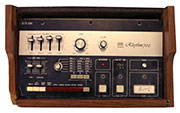 TR-700 Rhythm 700
TR-700 Rhythm 700
An extremely rare member of the TR family, this machine featured an inbuilt amplifier and speaker. It also offered a metronome, volume and tempo controls, as well as individual balance faders for Bass Drum, Snare Drum, Cymbals and Claves.
1973
TR-330 Rhythm 330
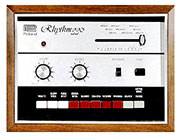 This was one of the the first rhythm machines to be housed in the wooden box-style that would come to characterize the Roland drum machines of the later 1970s. It offered eight analog drum sounds with volume and balance controls. The balance control was capable of completely muting either the hi-hats or bass drum. It also featured a built in amplifier and speaker.
This was one of the the first rhythm machines to be housed in the wooden box-style that would come to characterize the Roland drum machines of the later 1970s. It offered eight analog drum sounds with volume and balance controls. The balance control was capable of completely muting either the hi-hats or bass drum. It also featured a built in amplifier and speaker.
TR-66 Rhythm Arranger
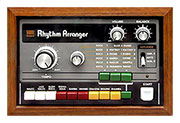 The TR-66 took pure analog sounds and arranged them into 18 different drum patterns, from rock, swing, march and dance styles. These patterns could then be mixed with the 9 additional stylized rhythm patterns – from Waltz, Cha-Cha, Bossa Nova, Rumba and more. With an additional A/B/Auto variation, there were hundreds of possible rhythm arrangements.
The TR-66 took pure analog sounds and arranged them into 18 different drum patterns, from rock, swing, march and dance styles. These patterns could then be mixed with the 9 additional stylized rhythm patterns – from Waltz, Cha-Cha, Bossa Nova, Rumba and more. With an additional A/B/Auto variation, there were hundreds of possible rhythm arrangements.
1978
CR-68 CompuRhythm
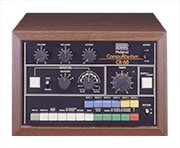 This analog rhythm machine was directly related to the classic CR-78, which shared the same sound set and rhythm patterns. It featured 34 different preset rhythms – 17 buttons with an AB toggle switch. It also included controls for volume, tempo, accent and balance, though it lacked the ability to program your own patterns. Although it was limited only to its preset patterns, it was a great sounding, much cheaper alternative to the CR-78. It also lacked the fade in/out feature that its successors enjoyed.
This analog rhythm machine was directly related to the classic CR-78, which shared the same sound set and rhythm patterns. It featured 34 different preset rhythms – 17 buttons with an AB toggle switch. It also included controls for volume, tempo, accent and balance, though it lacked the ability to program your own patterns. Although it was limited only to its preset patterns, it was a great sounding, much cheaper alternative to the CR-78. It also lacked the fade in/out feature that its successors enjoyed.
CR-800 CompuRhythm
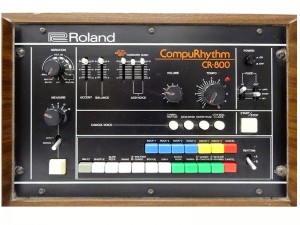 Sitting somewhere in between the CR-68 and CR-78, the CR-800 was the rarest of the range. It featured the same sounds and rhythms as the other CR machines, with the addition of a floor speaker cabinet. Although it was not programmable like the CR-78 is, it offered a greater amount of variations than the CR-68. The built-in sounds were a development on the sounds of the earlier Roland TR machines.
Sitting somewhere in between the CR-68 and CR-78, the CR-800 was the rarest of the range. It featured the same sounds and rhythms as the other CR machines, with the addition of a floor speaker cabinet. Although it was not programmable like the CR-78 is, it offered a greater amount of variations than the CR-68. The built-in sounds were a development on the sounds of the earlier Roland TR machines.
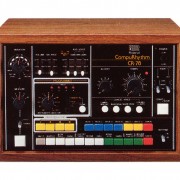 CR-78 CompuRhythm
CR-78 CompuRhythm
This classic analog rhythm machine was the first of its kind to use integrated circuits – an important development in the history of drum machines. This allowed for the introduction of a Programmer section, which provided 4 programmable memory locations for pattern storage. Now users could program and store their own drum patterns, as well as adjust tempo, accents, and fade ins and outs. Individual mute controls for each of the four voices were featured on the front panel, allowing the user to create breakdowns. It was used prominently on seminal tracks like ‘Heart of Glass’ by Blondie, and ‘In the Air Tonight’ by Phil Collins.
1979
BOSS Dr. Rhythm DR-55
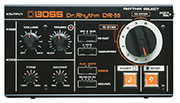 A landmark in BOSS’ rich history, the DR-55 was the first rhythm machine in its famed Dr. Rhythm Series. It featured only four sounds including Kick, Snare, Rim shot and Hi-Hat, and offered step-mode programming – a simple but effective method of writing in patterns. The play button was used to place the sound and the Stop button was used to step through the beat. It was one of the first programmable drum machines that was affordable to home musicians and had a significant impact on the musical landscape of the time.
A landmark in BOSS’ rich history, the DR-55 was the first rhythm machine in its famed Dr. Rhythm Series. It featured only four sounds including Kick, Snare, Rim shot and Hi-Hat, and offered step-mode programming – a simple but effective method of writing in patterns. The play button was used to place the sound and the Stop button was used to step through the beat. It was one of the first programmable drum machines that was affordable to home musicians and had a significant impact on the musical landscape of the time.
1980
TR-808 Rhythm Composer
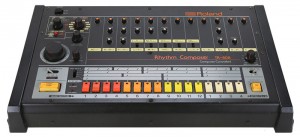 Futuristic in sound and design, it was initially released at a time when the digital recreation of real drum sounds was highly favoured over analog devices. As time passed, its affordable cost and unique analog sound made it popular in hip-hop and dance music styles. Its impact on the sound and development of these genres is undeniable. With its characteristic bass drum, which was able to produce very low frequencies, and its distinctive cowbells, the sound of the TR-808 was unmistakable. Used on more hit records than any other drum machine in history, it has come to be one of the most recognizable and celebrated drum machines ever.
Futuristic in sound and design, it was initially released at a time when the digital recreation of real drum sounds was highly favoured over analog devices. As time passed, its affordable cost and unique analog sound made it popular in hip-hop and dance music styles. Its impact on the sound and development of these genres is undeniable. With its characteristic bass drum, which was able to produce very low frequencies, and its distinctive cowbells, the sound of the TR-808 was unmistakable. Used on more hit records than any other drum machine in history, it has come to be one of the most recognizable and celebrated drum machines ever.
CR-8000 CompuRhythm
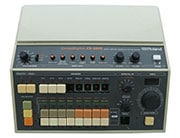 Created in the style of the CR-78, with the sounds of the TR-808, this machine bridged the two series together. It hosted a range of preset patterns in a variety of different styles, as well as programmable patterns with 8 patches of storage memory. None of the sounds were editable and there was only one mono audio output. The Swing/Groove control offered variable intervals between beats and alongside timbre changes.
Created in the style of the CR-78, with the sounds of the TR-808, this machine bridged the two series together. It hosted a range of preset patterns in a variety of different styles, as well as programmable patterns with 8 patches of storage memory. None of the sounds were editable and there was only one mono audio output. The Swing/Groove control offered variable intervals between beats and alongside timbre changes.
CR-5000 CompuRhythm
This machine was similar to the CR-8000 but without the tempo sync, display and with less sounds. With 9 sounds and 24 presets, it offered a Shuffle mode to randomize patterns, as well as an Accent knob for volume variation within the patterns. The Register button switched between Arranger and Preset settings, while the Crash button enabled the end of bar Crash cymbal sound.
TR-606 Drumatix
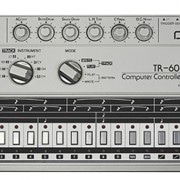 Featuring 7 analog voices, this machine could store up to 32 patterns and 8 songs. 4 consecutive patterns could be linked in Pattern Play mode, and it offered the ability to switch between Write and Play mode, without affecting playback; the only machine in the series to host this feature. This made it useful for both studio work and live performance. Portable and affordable, it was originally intended to be used alongside the TB-303, synchronized via DIN-sync. It proved to be capable in its own right, and was used on tracks by artists including Aphex Twin, Big Black, Nine Inch Nails, and Autechre.
Featuring 7 analog voices, this machine could store up to 32 patterns and 8 songs. 4 consecutive patterns could be linked in Pattern Play mode, and it offered the ability to switch between Write and Play mode, without affecting playback; the only machine in the series to host this feature. This made it useful for both studio work and live performance. Portable and affordable, it was originally intended to be used alongside the TB-303, synchronized via DIN-sync. It proved to be capable in its own right, and was used on tracks by artists including Aphex Twin, Big Black, Nine Inch Nails, and Autechre.
1983
BOSS Dr. Rhythm Graphic DR-110
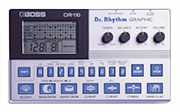 The next release in the BOSS DR Series, it featured some notable advances in technology. The introduction of an LCD graphic display supported a step grid for programming various drum parts. It allowed for drum sounds to be manually played from rubber pads, as well as the traditional method of programming beats. Other features include a globally variable accent knob, continuously variable Tempo and a V-trig clock pulse output to allow slave units to sync to the accent section.
The next release in the BOSS DR Series, it featured some notable advances in technology. The introduction of an LCD graphic display supported a step grid for programming various drum parts. It allowed for drum sounds to be manually played from rubber pads, as well as the traditional method of programming beats. Other features include a globally variable accent knob, continuously variable Tempo and a V-trig clock pulse output to allow slave units to sync to the accent section.
PB-300 Rhythm Plus
 This preset analog drum machine was originally released to expand on the Roland HP-300 and HP-400 pianos; the first of Roland’s digital pianos to feature MIDI integration. It was also used alongside the PR-800. It offered a Master/Slave switch, accent level control and variation switches, and was the last fully analog drum machine from Roland.
This preset analog drum machine was originally released to expand on the Roland HP-300 and HP-400 pianos; the first of Roland’s digital pianos to feature MIDI integration. It was also used alongside the PR-800. It offered a Master/Slave switch, accent level control and variation switches, and was the last fully analog drum machine from Roland.
TR-909 Rhythm Composer
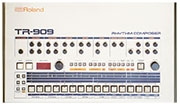 This machine was one of the first Roland instruments to be equipped with MIDI, and was the first analog/digital hybrid machine, combining analog circuits for its drums with digital samples for its cymbal and hi-hat sounds. Fully programmable, the sequencer section was incredibly powerful, allowing the user to chain 96 patterns into songs of up to 896 measures. The analog circuitry allowed for sounds with tweakable attack, tone, tuning, snap and accent parameters. The 909 sound was synthetic compared to its more expensive, digital sample-based counterparts, which were superior in reproducing real drum sounds. Over time however, this futuristic sound, coupled with its affordability, saw it reach new heights as an integral part of the techno movement during the 1990s.
This machine was one of the first Roland instruments to be equipped with MIDI, and was the first analog/digital hybrid machine, combining analog circuits for its drums with digital samples for its cymbal and hi-hat sounds. Fully programmable, the sequencer section was incredibly powerful, allowing the user to chain 96 patterns into songs of up to 896 measures. The analog circuitry allowed for sounds with tweakable attack, tone, tuning, snap and accent parameters. The 909 sound was synthetic compared to its more expensive, digital sample-based counterparts, which were superior in reproducing real drum sounds. Over time however, this futuristic sound, coupled with its affordability, saw it reach new heights as an integral part of the techno movement during the 1990s.
1984
TR-707 Rhythm Composer
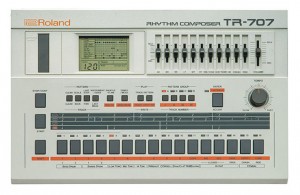 Featuring 15 digital sounds, sampled at 12 bits, the TR-707 hosted 64 programmable patterns that can be sequenced together to form 4 different songs. It offers external synchronization with MIDI and DIN sync, four levels of shuffle that operate globally, and a flam that could be applied to any step. There were also individual volume sliders for each instrument group, which was not common in digital drum machine designs. Its fresh sound and affordability made it a staple in early house and acid house music.
Featuring 15 digital sounds, sampled at 12 bits, the TR-707 hosted 64 programmable patterns that can be sequenced together to form 4 different songs. It offers external synchronization with MIDI and DIN sync, four levels of shuffle that operate globally, and a flam that could be applied to any step. There were also individual volume sliders for each instrument group, which was not common in digital drum machine designs. Its fresh sound and affordability made it a staple in early house and acid house music.
1985
TR-727 Rhythm Composer
 This was the Latin-inspired version of the TR-707. It had individual outputs and sliders, a shuffle and flam effect, Matrix display and an in-depth programming section. It also offered real-time and step recordings modes. These devices were primarily for programming rhythms and did not provide the user with sound editing possibilities.
This was the Latin-inspired version of the TR-707. It had individual outputs and sliders, a shuffle and flam effect, Matrix display and an in-depth programming section. It also offered real-time and step recordings modes. These devices were primarily for programming rhythms and did not provide the user with sound editing possibilities.
BOSS Dr. Rhythm DR-220A
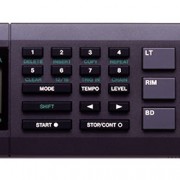 This machine was the first in a 2-part series of drum machines produced by BOSS. A, standing for Acoustic, represents the acoustic drum kit samples the device hosts. It featured the Matrix Display, alongside 12 pads with 11 corresponding drum sounds. The settings functions were accessed through the twelfth pad. Compact and affordable, these catered towards the budget studios and home musicians of the time.
This machine was the first in a 2-part series of drum machines produced by BOSS. A, standing for Acoustic, represents the acoustic drum kit samples the device hosts. It featured the Matrix Display, alongside 12 pads with 11 corresponding drum sounds. The settings functions were accessed through the twelfth pad. Compact and affordable, these catered towards the budget studios and home musicians of the time.
BOSS Dr. Rhythm DR-220E
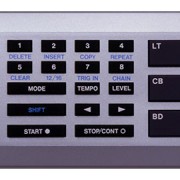 This was the Electric version of the Acoustic kit. The overall design is exactly the same, the only aesthetic difference being the lighter colour. The DR-220E featured 32 preset rhythms and an additional 32 rhythms in the user manual. It is widely noted for hosting very similar sounds to the Simmons SDS-V, one of the first electronic drum kits to be released.
This was the Electric version of the Acoustic kit. The overall design is exactly the same, the only aesthetic difference being the lighter colour. The DR-220E featured 32 preset rhythms and an additional 32 rhythms in the user manual. It is widely noted for hosting very similar sounds to the Simmons SDS-V, one of the first electronic drum kits to be released.
1986
TR-505 Rhythm Composer
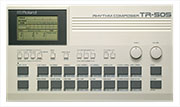 This machine contained a group of samples mixed from both the TR-707 and TR-727, and featured 16 drum tones, with 48 patterns and 6 songs of memory. Basic and affordable, it did not offer tone editing capabilities or individual drum outputs. It did host an extensive MIDI section, making it ideal alongside a computer or sequencer.
This machine contained a group of samples mixed from both the TR-707 and TR-727, and featured 16 drum tones, with 48 patterns and 6 songs of memory. Basic and affordable, it did not offer tone editing capabilities or individual drum outputs. It did host an extensive MIDI section, making it ideal alongside a computer or sequencer.
CR-1000 Digital Drummer
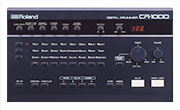 This preset digital rhythm machine featured 16 PCM sound sources. The sounds were similar to that of the TR-505, with both standard drums sounds and Latin percussion. It hosted 24 rhythm patterns, with 2 variations for each, and also offered MIDI In and Thru. Tempo, accent level and shuffle time were all adjustable and could be stored to each pattern.
This preset digital rhythm machine featured 16 PCM sound sources. The sounds were similar to that of the TR-505, with both standard drums sounds and Latin percussion. It hosted 24 rhythm patterns, with 2 variations for each, and also offered MIDI In and Thru. Tempo, accent level and shuffle time were all adjustable and could be stored to each pattern.
1987
TR-626 Rhythm Composer
 This 12-bit digital sample based machine was developed from the TR-505, but featured additional sounds and more control. It offered real-time and step recording modes, with 48 preset patterns and 48 user patterns. It’s simple matrix display showed the current pattern in a graphical representation and with 16 drum tone pads and 8 voices of polyphony, it was an advance on past models.
This 12-bit digital sample based machine was developed from the TR-505, but featured additional sounds and more control. It offered real-time and step recording modes, with 48 preset patterns and 48 user patterns. It’s simple matrix display showed the current pattern in a graphical representation and with 16 drum tone pads and 8 voices of polyphony, it was an advance on past models.
1988
RA-50 RealTime Arranger
 This machine was intended to be used alongside a Roland piano, to add an accompaniment for performance. It was a MIDI module with arranger functions and offered 30 variations of drum rhythms. The user could choose between basic or advanced versions of styles, giving a variety of different available accompaniments. It also featured 8 different MIDI configuration power up modes.
This machine was intended to be used alongside a Roland piano, to add an accompaniment for performance. It was a MIDI module with arranger functions and offered 30 variations of drum rhythms. The user could choose between basic or advanced versions of styles, giving a variety of different available accompaniments. It also featured 8 different MIDI configuration power up modes.
1989
R-5 Human Rhythm Composer
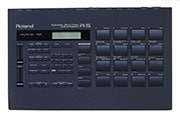 This machine was a simplified incarnation of the famed R-8 Human Rhythm Composer. Without the ROM card expansion slots, the available sounds were a set list. It did offer MIDI In, Out and Thru, and most parameters could be changed via MIDI. It also featured velocity sensitive pads, and flam and roll options, which could be held for a widening effect.
This machine was a simplified incarnation of the famed R-8 Human Rhythm Composer. Without the ROM card expansion slots, the available sounds were a set list. It did offer MIDI In, Out and Thru, and most parameters could be changed via MIDI. It also featured velocity sensitive pads, and flam and roll options, which could be held for a widening effect.
R-8 Human Rhythm Composer
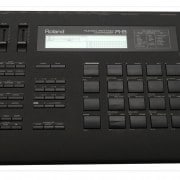 This machine offered diverse sounds with the ability to be expanded with additional 808 and 909 sound cards. It offered 100 patterns, 10 songs, and 68 sample-based instruments. The editing modes were versatile, allowing for individual pitch, decay, nuance, pan and velocity to be altered in real time as the pattern plays. It also featured a sequencer and Feel Patch function, which gave the sequences a human-like groove. This was done by altering various attributes of sounds within a pattern, based on a rhythm template or another kind of random variation. The second generation model, R-8 MkII, was released 3 years later and featured a new expanded set of on-board sounds.
This machine offered diverse sounds with the ability to be expanded with additional 808 and 909 sound cards. It offered 100 patterns, 10 songs, and 68 sample-based instruments. The editing modes were versatile, allowing for individual pitch, decay, nuance, pan and velocity to be altered in real time as the pattern plays. It also featured a sequencer and Feel Patch function, which gave the sequences a human-like groove. This was done by altering various attributes of sounds within a pattern, based on a rhythm template or another kind of random variation. The second generation model, R-8 MkII, was released 3 years later and featured a new expanded set of on-board sounds.
BOSS Dr. Rhythm DR-550
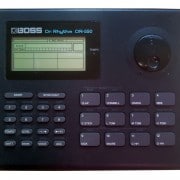 The next release in BOSS’ Dr. Rhythm series, this machine developed on the rather limited DR-220 range. Moving from 12-bit to 16-bit conversion, the DR-550’s sound quality was vastly superior. With more memory capacity, this device was able to integrate a wider range of both acoustic and electric sounds, hosting 48 sounds in total. Programming was still quite simple and with no velocity control, it was difficult to avoid the mechanical nature of the drum rhythms. MIDI In meant it could be slaved to external machines. The DR-550 MkII was released in 1992 and featured additional sound sources.
The next release in BOSS’ Dr. Rhythm series, this machine developed on the rather limited DR-220 range. Moving from 12-bit to 16-bit conversion, the DR-550’s sound quality was vastly superior. With more memory capacity, this device was able to integrate a wider range of both acoustic and electric sounds, hosting 48 sounds in total. Programming was still quite simple and with no velocity control, it was difficult to avoid the mechanical nature of the drum rhythms. MIDI In meant it could be slaved to external machines. The DR-550 MkII was released in 1992 and featured additional sound sources.
1991
CR-80 Human Rhythm Player
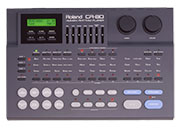 This 16-bit pre-programmed rhythm machine offered a vast variety of rhythmic patterns, with a characteristically human feel. It had a total of 69 in-built sounds, in 36 available styles. Each style had 4 variations, which meant a total of 144 patterns were possible. Featuring 12-note polyphony, MIDI In and Out, as well as individual volume faders for each drum sound, the machine also introduced a Feel fader. This fader varied the quantization to make the rhythm sound more or less-human.
This 16-bit pre-programmed rhythm machine offered a vast variety of rhythmic patterns, with a characteristically human feel. It had a total of 69 in-built sounds, in 36 available styles. Each style had 4 variations, which meant a total of 144 patterns were possible. Featuring 12-note polyphony, MIDI In and Out, as well as individual volume faders for each drum sound, the machine also introduced a Feel fader. This fader varied the quantization to make the rhythm sound more or less-human.
1992
R-70 Human Rhythm Player
Featuring up to 210 drum sounds, in all styles of music, it was a popular machine of its time. It offered a highly programmable sequencer, with real time and step input mods. It could hold 100 patterns, which could be chained into 20 songs. It also introduced a unique position pad, which the user could assign any sound to. The sonic characteristics of the sound would then change depending on where the pad was hit.
BOSS Dr. Rhythm DR-660
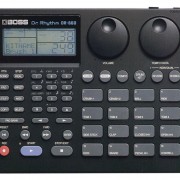 This device was a milestone in the Dr. Rhythm series of drum machines. With hundreds of samples arranged into 32 preset kits, many different styles of music were covered. TR-808 and TR-909 kits were included and there were further spaces for user-assembled kits. It included a Pad Layer function that enabled users to combine samples, allowing for endless possibilities, as well as onboard digital effects including reverb, delay and chorus.
This device was a milestone in the Dr. Rhythm series of drum machines. With hundreds of samples arranged into 32 preset kits, many different styles of music were covered. TR-808 and TR-909 kits were included and there were further spaces for user-assembled kits. It included a Pad Layer function that enabled users to combine samples, allowing for endless possibilities, as well as onboard digital effects including reverb, delay and chorus.
1993
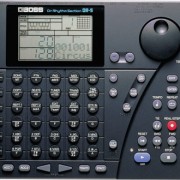 BOSS Dr. Rhythm DR-5
BOSS Dr. Rhythm DR-5
An innovative new concept in the development of rhythm composers, it was designed to emulate a guitar fretboard and featured programmable drums, bass and keys. It offered 256 sounds, with 16-bit resolution, and 64 drum kits. It also featured a guitar input with a built in tuner and amp simulator – a design feature that would be fully realized later in the Dr. Rhythm series.
1996
MC-303 Groovebox
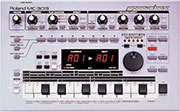 This device was the first Groovebox released in the MC Series. It featured 448 preset sounds and 12 drum kits, including sounds from the CR-78, TR-808, TR-606 and TR-909. It also included a full 8-track sequencer, alongside 300 onboard dance music variation patterns, with drum beats and basslines. Inexpensive and flexible, it targeted dance music producers and amateur home musicians.
This device was the first Groovebox released in the MC Series. It featured 448 preset sounds and 12 drum kits, including sounds from the CR-78, TR-808, TR-606 and TR-909. It also included a full 8-track sequencer, alongside 300 onboard dance music variation patterns, with drum beats and basslines. Inexpensive and flexible, it targeted dance music producers and amateur home musicians.
1998
MC-505 Groovebox
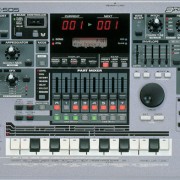 Released two years after the first Groovebox, the MC-505 introduced a range of new features to the MC Series. The MEGAMix function encouraged real-time mixing of beats and sounds, improving its live performance capability. A D-Beam controller was also added for hands-free sound modulation, as well as additional sounds, presets, kits and user banks.
Released two years after the first Groovebox, the MC-505 introduced a range of new features to the MC Series. The MEGAMix function encouraged real-time mixing of beats and sounds, improving its live performance capability. A D-Beam controller was also added for hands-free sound modulation, as well as additional sounds, presets, kits and user banks.
BOSS Dr. Groove DR-202
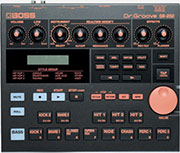 This programmable drum machine had 207 drum and 49 bass sounds, arranged in 128 different kits. It offered over 400 patterns, traversing a number of styles that reflected the upcoming electronic dance music styles of the time. These included jungle, drum & bass, techno, house and acid jazz. Compact but extremely powerful, it hosted MIDI out, a sequencer, and 13 pads that could be played like a piano, or used to trigger drums.
This programmable drum machine had 207 drum and 49 bass sounds, arranged in 128 different kits. It offered over 400 patterns, traversing a number of styles that reflected the upcoming electronic dance music styles of the time. These included jungle, drum & bass, techno, house and acid jazz. Compact but extremely powerful, it hosted MIDI out, a sequencer, and 13 pads that could be played like a piano, or used to trigger drums.
BOSS Dr. Rhythm DR-770
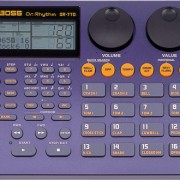 With twice as much in-built memory as its predecessor the DR-660, this new device was a powerhouse of it time. With its enhanced memory, it offered expanded sound editing control, 2 reverb types, 2 flanges, and a 2-band EQ. It came with 255 individual drum sounds, 64 preset drum kits, 64 user programmable kits, and hundreds of preset drum patterns. It also introduced a new Ambience control with 16 available settings, as well as a handy Quick Search function. Cutting edge at the times of its release, this machine was flexible, powerful and affordable.
With twice as much in-built memory as its predecessor the DR-660, this new device was a powerhouse of it time. With its enhanced memory, it offered expanded sound editing control, 2 reverb types, 2 flanges, and a 2-band EQ. It came with 255 individual drum sounds, 64 preset drum kits, 64 user programmable kits, and hundreds of preset drum patterns. It also introduced a new Ambience control with 16 available settings, as well as a handy Quick Search function. Cutting edge at the times of its release, this machine was flexible, powerful and affordable.
1999
MC-307 Groovebox
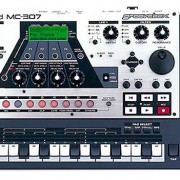 The next Groovebox in the MC series was a scaled down version of the MC-505. Targeting DJs of the time, it introduced the new Turntable Emulation mode, which affected the pattern tempo and pitch just as a turntable would. It offered 4 assignable CV controllers and 240 onboard dance music patterns, alongside its 8-track sequencer and large granular tempo slider. It also featured the same tone generator as its predecessor, but had a significantly smaller control surface, no D-Beam and less features
The next Groovebox in the MC series was a scaled down version of the MC-505. Targeting DJs of the time, it introduced the new Turntable Emulation mode, which affected the pattern tempo and pitch just as a turntable would. It offered 4 assignable CV controllers and 240 onboard dance music patterns, alongside its 8-track sequencer and large granular tempo slider. It also featured the same tone generator as its predecessor, but had a significantly smaller control surface, no D-Beam and less features
2001
BOSS Dr. Rhythm DR-670
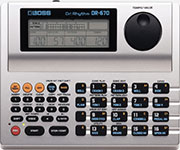 This device takes the sounds of the DR-770 and adds velocity-sensitive pads and footswitch control. Its offers 255 waveforms, with 64 preset kits and 64 user kits. With Direct Pattern Play, users are able to assign patterns to pads, allowing triggering on the fly. Compact and affordable, this set a new standard in the Dr. Rhythm series.
This device takes the sounds of the DR-770 and adds velocity-sensitive pads and footswitch control. Its offers 255 waveforms, with 64 preset kits and 64 user kits. With Direct Pattern Play, users are able to assign patterns to pads, allowing triggering on the fly. Compact and affordable, this set a new standard in the Dr. Rhythm series.
D-2 GrooveMachine
 This Groovebox was designed entirely around Roland’s D-Field Controller technology. The touch-sensitive pad in the center allows the user to program and modify patterns, sounds and effects. The D-Field controller offers 3 modes – Sounds, XY and Spin, which makes it an interesting device for real-time based performance. It takes its 600 preset patches and 30 preset drum kits from the MC-505 and also features a similar sequencer with 150 new preset patterns.
This Groovebox was designed entirely around Roland’s D-Field Controller technology. The touch-sensitive pad in the center allows the user to program and modify patterns, sounds and effects. The D-Field controller offers 3 modes – Sounds, XY and Spin, which makes it an interesting device for real-time based performance. It takes its 600 preset patches and 30 preset drum kits from the MC-505 and also features a similar sequencer with 150 new preset patterns.
2002
MC-909 Groovebox
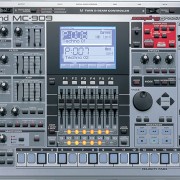 This machine introduced a sampler into the Groovebox series. It is based on the XV-series synthesis engine with sampling RAM expandable up to 272MB. Samples can be used as raw waveforms in the synthesizer section, adding to the improved flexibility of the machine. The sequencer has advanced from 8 tracks to 16 and features 800 new Patches, 64 Rhythm Sets and 693 new waveforms with SRX expansion. It offers studio-quality effect including 24-bit reverb, 2 multi-effects processors, compression, EQ and mastering effects.
This machine introduced a sampler into the Groovebox series. It is based on the XV-series synthesis engine with sampling RAM expandable up to 272MB. Samples can be used as raw waveforms in the synthesizer section, adding to the improved flexibility of the machine. The sequencer has advanced from 8 tracks to 16 and features 800 new Patches, 64 Rhythm Sets and 693 new waveforms with SRX expansion. It offers studio-quality effect including 24-bit reverb, 2 multi-effects processors, compression, EQ and mastering effects.
2003
BOSS Dr. Rhythm DR-3
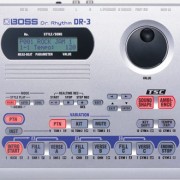 At the time of its release, it was one of BOSS’ most affordable drum machines for guitarists and songwriters. Loaded with acoustic and electronic drum samples, it offers 100 presets styles and 100 user styles, both of which are programmable through real-time and step recording. The Total Sound Control (TSC) feature provides further control, enabling users to shape the sound of a drum kit with specialized effects.
At the time of its release, it was one of BOSS’ most affordable drum machines for guitarists and songwriters. Loaded with acoustic and electronic drum samples, it offers 100 presets styles and 100 user styles, both of which are programmable through real-time and step recording. The Total Sound Control (TSC) feature provides further control, enabling users to shape the sound of a drum kit with specialized effects.
2004
BOSS Dr. Rhythm DR-880
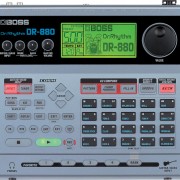 Packed with drum, percussion and bass sounds from BOSS’ famed SRX library, it also includes an epic collection of original waveforms. It features a guitar/bass input jack, which allows guitarists to play through the built-in COSM Drive/Amp models, and make use of the included multi-effects. The Groove Modify feature applies various groove and triplet feels to your sequences. While the sequencer section goes deep, it also offers three EZ Compose buttons, which simplify the process of programming.
Packed with drum, percussion and bass sounds from BOSS’ famed SRX library, it also includes an epic collection of original waveforms. It features a guitar/bass input jack, which allows guitarists to play through the built-in COSM Drive/Amp models, and make use of the included multi-effects. The Groove Modify feature applies various groove and triplet feels to your sequences. While the sequencer section goes deep, it also offers three EZ Compose buttons, which simplify the process of programming.
2006
MC-808 Groovebox
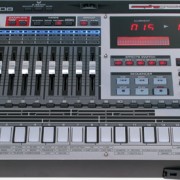 The final Groovebox in the MC Series hosts an array of impressive new features. Optimized for real-time performance, the MC-808 introduces eight motorized faders, giving the user more control and reliability for live performance. It offers new sounds and patterns, though still shares the sampling and sequencing features that made its predecessor, the MC-909, so popular.
The final Groovebox in the MC Series hosts an array of impressive new features. Optimized for real-time performance, the MC-808 introduces eight motorized faders, giving the user more control and reliability for live performance. It offers new sounds and patterns, though still shares the sampling and sequencing features that made its predecessor, the MC-909, so popular.
2014
AIRA TR-8 Rhythm Performer
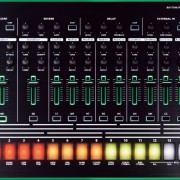 This is the next step in the evolution of Roland TR drum machines. It takes the best features of the legendary TR-808 and TR-909 machines and couples them with innovative design and technological advances. The newly developed Analog Circuit Behaviour (ACB) technology, allows for a faithful recreation of the tonality and behavior of the original machines. With a strong emphasis on live performance application, the user is able to easily switch between programming and performance modes. With MIDI and USB sync, alongside USB recording, and the introduction of the Scatter section, this is the drum machine that will lead us into the future.
This is the next step in the evolution of Roland TR drum machines. It takes the best features of the legendary TR-808 and TR-909 machines and couples them with innovative design and technological advances. The newly developed Analog Circuit Behaviour (ACB) technology, allows for a faithful recreation of the tonality and behavior of the original machines. With a strong emphasis on live performance application, the user is able to easily switch between programming and performance modes. With MIDI and USB sync, alongside USB recording, and the introduction of the Scatter section, this is the drum machine that will lead us into the future.

